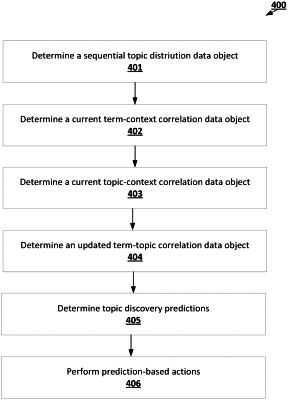| CPC G06F 40/30 (2020.01) [G06F 40/279 (2020.01); G06N 5/02 (2013.01); G06N 5/04 (2013.01); G06N 20/00 (2019.01)] | 20 Claims |

|
1. A computer-implemented method for sequential topic modeling, the computer-implemented method comprising:
determining, using one or more processors and based at least in part on a sequential term distribution data object for a current document sequence and a prior term-topic correlation data object, a sequential topic distribution data object for the current document sequence;
determining, using the one or more processors and based at least in part on a sequential context distribution data object for the current document sequence, a current term-context correlation data object for the current document sequence;
determining, using the one or more processors and based at least in part on the current term-context correlation data object for the current document sequence, a current context-topic correlation data object for the current document sequence;
determining, using the one or more processors and based at least in part on the sequential topic distribution data object and the current context-topic correlation data object, an updated term-topic correlation data object;
determining, using the one or more processors, one or more topic modeling predictions for the current document sequence based at least in part on the sequential topic distribution data object and the updated term-topic correlation data object; and
performing, using the one or more processors, one or more prediction-based actions based at least in part on the one or more topic modeling predictions.
|